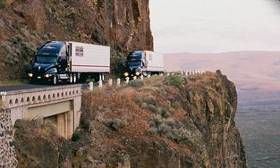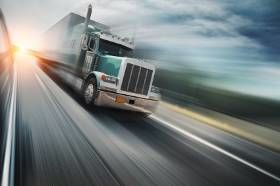Making The Sleeper Cozy Like Your Home
Topic 12161 | Page 7

I've thought that leasing or. using might not be bad, but I'll wait at least a year. maybe more.

So I have to agree with Rick as well. It's one thing to plan and fantasize about all the ways you're going to customize the truck, but reality is going to prove entirely different.
I was the same as RV and Red. I had all these notions of what it was going to be like, all the little comforts I was going to have, etc. But you really have to be on your own out on the road for a while before you can really understand the limitations.
The thing is, there are so many other things that you'll need to bring with you that you won't even consider. And everything takes up some amount of space, no matter how small. And space is extremely limited. So you're gonna have to prioritize at some point. A few small items that take up hardly any space can quickly add up to a large percentage of the available space in a truck.
Just looking around my truck, I have the following things taking significant amounts of space:
- A month's worth of clothing. Unless you want to spend time and money doing laundry in truck stops frequently, you'll want to bring as much clothing as possible. This includes lots of underwear and socks, many pairs of pants, shirts, thick jackets, muck boots, steel toe boots, tennis shoes, rain gear, safety gear, hard hat, gloves, hats, etc. And remember to account for those days when you'll have to go through 2 or even 3 sets of clothes because you had to chain up in the snow or you got muddy doing your pre-trip.
- Dirty laundry bag. This can fill up mighty quickly and will consume more and more space the longer you stay out. I have the cord on mine tied to a button in the ceiling upholstry. When I drive, it sits on the foot of my bed. When I sleep, it sits on top of the clean clothes on the narrow shelf above my bed.
- Food. Similar to the clothing, unless you want to make frequent, time-consuming grocery runs, you'll want to stock up on as much food as possible. I have a big cardboard box under my bed filled with cereal, canned soup, tuna, canned fruit, etc. On the shelves above my fridge I have snack bars, popcorn, bread, spices, rice, canned veggies, and lots of other assorted little food items. And don't forget you need room for plates/utensils, cookware (that's a whole shelf of its own), and cleanup items like soap, rags, paper towels, etc.
- "Office supplies." The entire passenger seat area of my truck is devoted to this. I have a cheap 3-drawer plastic cabinet from Walmart that sits facing me on the floor in front of my passenger seat. This stores my blank trip envelopes and delivery receipts, old logs, instructional material for different scenarios (e.g. instructions on load securement, Canadian ops and winter driving), my truck stop guide, as well as a few readily accessible snack items. I also have a seat-back organizer which I placed over the passenger seat, facing forward, that I use to store pens, my passport, some ibuprofen, gloves, and other little knick knacks. The seat itself is where I put my logbook , bills of lading, and any other paper which is directly relevant to what I am currently doing.
- On top of all this, you'll still have to find room for toiletries/medical items, various cleaning supplies, tons of different tools, trash bags... the list literally goes on and on and on.
So when you've found a good place for all of this, then you can start filling in any gaps with your personal comforts.
Oh and don't forget, everything has to be secure. That means you can't just have a Yankee Candle sitting on a shelf, because the minute you slam on the brakes that thing will go flying (Sorry RV!). Not to mention when you're driving through a state like Indiana like I did yesterday, the roads will be so bumpy that anything and everything that can possibly fall will find a way to do so.
So I have to agree with what was stated earlier: take all the comforts you think you'll have room for and cut it down by half. Then leave all that stuff at home your first time out. Plan to live a totally spartan lifestyle on your first run. Then slowly start adding things with each successive run. That would be the best way to do it I think.
Logbook:
A written or electronic record of a driver's duty status which must be maintained at all times. The driver records the amount of time spent driving, on-duty not driving, in the sleeper berth, or off duty. The enforcement of the Hours Of Service Rules (HOS) are based upon the entries put in a driver's logbook.
HOS:
Hours Of Service
HOS refers to the logbook hours of service regulations.OWI:
Operating While Intoxicated
Geez Persian......you just uncovered a simple and obvious idea that I had totally missed. Although we have an awesome list of Items To Bring To CDL School, Training, and OTR and a great list of Winter Driving Tips & Items To Bring, we don't have anything to show what people already have in their truck. We should maybe start a new conversation just for that.
CDL:
Commercial Driver's License (CDL)
A CDL is required to drive any of the following vehicles:
- Any combination of vehicles with a gross combined weight rating (GCWR) of 26,001 or more pounds, providing the gross vehicle weight rating (GVWR) of the vehicle being towed is in excess of 10,000 pounds.
- Any single vehicle with a GVWR of 26,001 or more pounds, or any such vehicle towing another not in excess of 10,000 pounds.
- Any vehicle, regardless of size, designed to transport 16 or more persons, including the driver.
- Any vehicle required by federal regulations to be placarded while transporting hazardous materials.
OTR:
Over The Road
OTR driving normally means you'll be hauling freight to various customers throughout your company's hauling region. It often entails being gone from home for two to three weeks at a time.

Geez Persian......you just uncovered a simple and obvious idea that I had totally missed. Although we have an awesome list of Items To Bring To CDL School, Training, and OTR and a great list of Winter Driving Tips & Items To Bring, we don't have anything to show what people already have in their truck. We should maybe start a new conversation just for that.
I can't tell if you're being sarcastic or serious...

CDL:
Commercial Driver's License (CDL)
A CDL is required to drive any of the following vehicles:
- Any combination of vehicles with a gross combined weight rating (GCWR) of 26,001 or more pounds, providing the gross vehicle weight rating (GVWR) of the vehicle being towed is in excess of 10,000 pounds.
- Any single vehicle with a GVWR of 26,001 or more pounds, or any such vehicle towing another not in excess of 10,000 pounds.
- Any vehicle, regardless of size, designed to transport 16 or more persons, including the driver.
- Any vehicle required by federal regulations to be placarded while transporting hazardous materials.
OTR:
Over The Road
OTR driving normally means you'll be hauling freight to various customers throughout your company's hauling region. It often entails being gone from home for two to three weeks at a time.
Serious, I think. It was a great post! Thanks for 'showing' us your cab.
OWI:
Operating While Intoxicated
Persian, your post gave me "flashbacks" of your experience with hauling all your stuff back to your house after it got thrown from your truck in that roll-over accident.

Geez Persian......you just uncovered a simple and obvious idea that I had totally missed. Although we have an awesome list of Items To Bring To CDL School, Training, and OTR and a great list of Winter Driving Tips & Items To Bring, we don't have anything to show what people already have in their truck. We should maybe start a new conversation just for that.
With pics.
~scott
CDL:
Commercial Driver's License (CDL)
A CDL is required to drive any of the following vehicles:
- Any combination of vehicles with a gross combined weight rating (GCWR) of 26,001 or more pounds, providing the gross vehicle weight rating (GVWR) of the vehicle being towed is in excess of 10,000 pounds.
- Any single vehicle with a GVWR of 26,001 or more pounds, or any such vehicle towing another not in excess of 10,000 pounds.
- Any vehicle, regardless of size, designed to transport 16 or more persons, including the driver.
- Any vehicle required by federal regulations to be placarded while transporting hazardous materials.
OTR:
Over The Road
OTR driving normally means you'll be hauling freight to various customers throughout your company's hauling region. It often entails being gone from home for two to three weeks at a time.

Alright then!
I'm on my way to Cape Charles, VA now, where I will be sitting until Monday waiting to unload, so that will be a good time for me to tidy up a bit, take lots of pics, and write up a detailed inventory of my truck. I'll start the new thread this weekend.
Geez Persian......you just uncovered a simple and obvious idea that I had totally missed. Although we have an awesome list of Items To Bring To CDL School, Training, and OTR and a great list of Winter Driving Tips & Items To Bring, we don't have anything to show what people already have in their truck. We should maybe start a new conversation just for that.
I can't tell if you're being sarcastic or serious...
I'm being totally serious. People that have never driven trucks or lived on the road have no clue what the inside of a truck looks like or how it's organized. The first time I ever saw the inside of a big rig was the first time I climbed into one at truck driving school. I had no clue what they were like. So I think people would totally dig seeing how people mount their television, refrigerator, inverter, and all that.....clothing, snacks, the whole deal.
CDL:
Commercial Driver's License (CDL)
A CDL is required to drive any of the following vehicles:
- Any combination of vehicles with a gross combined weight rating (GCWR) of 26,001 or more pounds, providing the gross vehicle weight rating (GVWR) of the vehicle being towed is in excess of 10,000 pounds.
- Any single vehicle with a GVWR of 26,001 or more pounds, or any such vehicle towing another not in excess of 10,000 pounds.
- Any vehicle, regardless of size, designed to transport 16 or more persons, including the driver.
- Any vehicle required by federal regulations to be placarded while transporting hazardous materials.
OTR:
Over The Road
OTR driving normally means you'll be hauling freight to various customers throughout your company's hauling region. It often entails being gone from home for two to three weeks at a time.
New Reply:
New! Check out our help videos for a better understanding of our forum features

















Preview:
This topic has the following tags:
Food & Eating On The Road Items To Bring On The Road Truck Equipment Truckers Technology







 TT On Facebook
TT On Facebook
Lollll